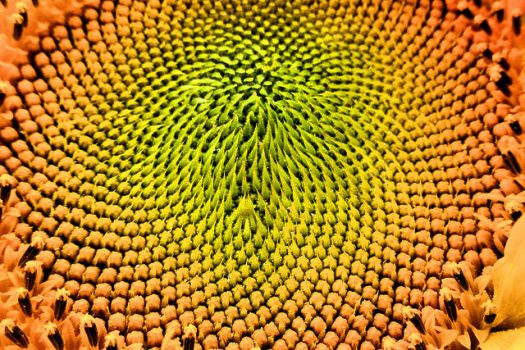Mathematical Equations of Perfection in Nature
By Kathryn Magendie | January 12, 2019 |

Photo Credit: Pictoscribe – Fibonacci Math
Nobody’s perfect, I thought by myself to myself, as I walked my mountain cove one spring morning.
I am measuring me against me. The time of writing consistently and arrogantly and prolifically against the me now who watches her bank account as if it may disappear while sleeping—and it often does, what with auto-pay ripping out its due. There should never be a time in an author’s life when what you loved so fervently and beautifully is placed away on a shelf while Real Life Stuff, like work to pay bills, takes priority. But any sentence that begins with “there should never be a time …” is often an idealistic wishful thought.
There is not a perfection of time, or place, or words, or language, or books, or people.
What’s all this stuff around me? Growth and abundance where just a month before was brown and sticks and sepia tones. Huh.
I inhaled clean mountain air. Alongside the road I walked that morning many wildflowers and wild plants, some unique and rare and beautiful, grow in a seemingly random way. Is it random, though, after all? A daisy caught my eye, then another and another. My eye focused, refocused, honed in. There. The inside of the daisy. That circle. How can it look so perfect yet so random and imperfect?
I asked my dog, who often indulges me. Lil Bear has listened to me spout off about characters and places and things without boredom. Because, my friends, there is really nothing more boring than to hear a writer talk about his or her book. I refuse to do that to anyone, except my dog, or inside my own crowded head. If someone asks, “What is your book about?” I know they really do not want to know more than a sentence or two, perhaps three if I say it really energetically—and if they want more, they’ll ask for more, and really, how often does that happen? haha! So, I asked Bear, “Is there a perfect, absolutely perfect, circle of yellow inside that flower? A perfect so perfect it can be measured mathematically? There is an equation for it. I think I read that somewhere. Or saw it on Nova. Yeah. And it’s called the Fibonacci Sequence or something like that. And it’s all over nature, and art, and music, since time began even, since the big bang, since . . . .”
My dog yawned. Well, there goes my “he’s never bored” statement shot all’a to hell.
I am not a mathematician, and indeed, mathematics puzzles me, frustrates me—always logical, always right, always perfect? I am such a Right-Brainer, if we will speak in stereotypes and clichés, and we do! we will! I imagine the right hemisphere of my brain is swollen and pulsing, the synapses firing off chaotically, but with their own kind of weird organization caused by complete disorganization’s attempts to make sense of it all; however, I imagine my left hemisphere as a bit flat and aloof, sitting stoic at a desk while reading important stuff that it won’t share with the right brain (because the right brain can’t, or won’t, listen).
If I could merge my left and right sides better, as many may be able to do, I could write books with intricate fantastical plots! I could perhaps make the gorgeous black hole in my brain open up the darkness and provide in more detailed logic what hides there. Alas. Dang.
I wonder, if a mathematician were to measure the golden inside of the daisy (and I am certain this has been done, of course!), would it be an absolute circle every single time for every single daisy? The eye finds an imperfectly perfect circle. I need to know, for the eye gauge is not enough, since the brain will imply and waver and be indecisive and wander and wonder and is awfully awesomely fickle at times. Is the soft sun inside of the daisy chaotic and wild or controlled and perfect, or something in between? Who will measure for me and then let me know?
I just have a need to know if there is some order to the daisy that I never noticed before. You see? No? Yes? Are you yawning? I bet you are. Dang.
I imagine mathematics both calms and excites the innards of the left brainers as my creative chaos both stills and energizes my right brain. I imagine there are those who aren’t One or T’other but kindee in the middle, and boy that must be so cool.
Somewhere out there are people whose left hemispheres pulse like my right hemisphere and can figure all this out. I bet we could write a book together. They’d control my chaos; I’d control their logic. We’d work together in this weird symmetry and have many arguments that end with coffee and a big piece of pie. Or one of us (the left brainer, I can tell you that now) stomping off in complete and utter frustration.
My left-brain partner-in-writing would be shaking their head over this entire post. “What are you writing? What are you doing? You are all over the place! What is this about?”
“Nobody’s perfect,” I’d say, sipping my coffee with a quirked expression.
“It’s not about perfection,” they’d say, sipping their coffee with a cocked eyebrow. “It’s about—”
—and I can’t finish that thought logically because I’m writing this without my left-brained helper. Yet, I find my own logic in everything I am writing to you. Can you see it?
Right now, it’s cold outside. There is no daisy. There is cold. There is wind. There is the comforting sound of my fingers typing on the keys (oh, it hurts to hear it sometimes when it is for bill paying work and not for My Work). There is a fire in the fireplace. There is all the dead-looking vegetation out there that hides all the big bursting of color and green that will come this spring. How organized nature is, even when it seems to be chaotic and wild. I bet nature could write a really cool book. And nature wouldn’t stop even if it went dormant for just a season or so. Because in its dormancy there would be preparation. Nature doesn’t give up. It doesn’t have that luxury. Nature gives up and it dies.
The daisy—with all its Fibonacci-ness. All of those flowers flung out randomly in a most unrandom way. God (the exclamation not the deity), I find that beautiful.
And there. I’ve emptied my brain, just a little, to make room for more chaos. I’ve distracted myself from the novel lying not-even-half-written. I’ve fiddle-dee-dee’d across the Writer Unboxed blog page—what else is new there, eh? one may ask.
I am done here for the moment.
Where does your brain lie? Right, left, or a sweet merging of the two? How do you measure your world? Will you ever write so imperfectly perfect again? Or have you never ever stopped, and believe you never ever will? If you are left-brained, or somewhere in between, can you finish the sentence above?
(And, yes, that’s a sunflower and not a daisy)









Right, left, or a sweet merging of the two?
My written writing process, developed over the past twenty plus years dealing with a non-working brain, is in a file entitled LeftBRAINrighT, and isn’t quite a merging, but it is a deliberate oscillation.
Some tasks are logical, others intuitive, and I find pushing the tasks as far as they will go – and that ‘side’ of the brain stops providing answers, while the other ‘side’ demands a turn – in a regular alternation, gets me to finished prose much more quickly than dawdling and hoping for inspiration.
It is recursive: a logical choreography with intuition. I go through the same steps with each new scene-partner, and we end up at the same place – thanking each other for the dance.
Sample steps:
L: Deal with fears for today. Remind self I ALWAYS do.
…OMEN …being THIS character (read prev. scenes) :R
Everything gets a turn, and the answers always get written down, while I’m accumulating. And each item will get reviewed until it is included satisfactorily in the scene – and I can check it off the list.
The process results in a lot of words around the scene, most of which don’t ever get revisited when the scene is finished (but which I’m finding a ready source of backstage material for my Patreon), but it gets them out of my head and onto an external searchable medium, which compensates for the physical brain not performing this task internally any more.
Much slower than internal processing, it is also much richer, because ideas and thoughts produced by the brainstorming are available to read whenever I can’t come up with new ones – and serve as triggers.
How such an awkward process results in written, finished fiction is a mystery, but once I’ve done all the preparation, it works.
Maybe it is ‘sweet merging.’
All I know is that I can’t write anything without the alternating process, and with it leaves me breathless – and wondering where it all came from.
Coolest.Comment.Ever!
And I am a FIRM believer in trusting our process instead of doing what we think we “should” or what some other writer or industry professional says they do or we should do – nope, trust out process!
Why, thank you.
I just recovered the whole process after a coast-to-coast move that has consumed the past year, and all I had to do was trust that I had recorded all the pieces.
Some I rediscovered, others reinvented themselves, but there was remarkably little added – and I’m back in the saddle, with the longest scene to write ever finished a couple of days ago, and the next one coming together already.
If I had trusted to memory, it would be lost.
What amazes me is that it feels seamless. I can only shake my head – and keep going.
The Personal Process never fails :D
Hi, Kathryn:
As a former math major, I couldn’t help but smile through much of this. If you want to disabuse yourself of the notion that math somehow embodies perfection, I suggest two books:
Incompleteness, by Rebecca Goldstein (an excellent examination of Kurt Gödel’s Incompleteness/inconsistency proofs that seriously undermined the notion of math as a perfectly complete and consistent logical system — a result that Gödel himself abhorred).
Morris Kline’s Mathematics: The Loss of Certainty (which details not just Gödel’s work but a number of paradoxes, dead ends, and other problems that arose in 20th century mathematics).
Math is a lovely and powerful language. But as Einstein noted, it’s something of a miracle math applies to the real world at all.
Lovely post. Thanks!
Thank you David! I will check out those books.
*laughing* I wondered if a Math Person would read this and what reaction they’d have :D
That question of whether Math is a nature-‘invented’ phenomenon or completely human-constructed. I think somewhere in between of course. We see patterns in our world, numerical or otherwise, and have to make sense of them. We love making sense of things! And nature often creates repeating patterns.
My brain skitters along from one side to the next. I know I read student papers that are sometimes grammatically perfect but lifeless and papers that are messes but filled with spirit. I think there’s a lesson for me in there.
Yes!
When I edit a book, I’d rather work my tail off to help the writer ‘fix up’ their interesting lively book than to have an ‘easy’ job of trying to bring life to a boring wooden book.